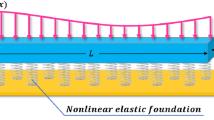Abstract
In this paper different architectures of Artificial Neural Networks (ANNs) for structural damage detection are studied. The main objective is to investigate an ANN able to detect and localize damage without any prior knowledge on its characteristics so as to serve as a real-time data processor for Structural Health Monitoring (SHM) systems. Two different architectures are studied: the standard feed-forward Multi Layer Perceptron (MLP) and the Radial Basis Function (RBF) ANNs. The training data are given, in terms of a Damage Index ℑD, properly defined using a piezoelectric sensor signal output to obtain suitable information on the damage position and dimensions. The electromechanical response of the assembled structure has been computed by means of a Multidomain Boundary Element code developed in the framework of piezoelectricity. On this basis, the neural networks are then used to recognize the location of the damage and its characteristics and the numerical results highlight the main differences on the performances of the two different ANNs analyzed.
Similar content being viewed by others
References
D. Balageas, C. Fritzen, A. Guemes, “Structural Health Monitoring”, ISTE, London, UK, 2006.
W. J. Staszewski, C. Boller, G. Tomlison, “Health Mon-itoring of Aerospace Structures Smart sensor technologies and signal processing”, John Wiley and Sons Ltd, 2004.
S. Grondel, J. Assaad, C. Delebarre, E. Moulin, “Health monitoring of composite wingbox structure”, Ultrasonics, 42, pp. 819–824, 2004.
I. Chopra, “Review of State of Art of Smart Structures and Integrated Systems”, AIAA Journal, 40(10), pp. 2145–2187, 2002.
D. M. Pearis, G. Park, D. J. Inman, “Improving accessibility of the impedance-based Structural Health Monitoring”, Journal of Intelligent Material Systems and Structures, 15, pp. 129–139, 2004.
T. Liu, V. Martin, K. Sritawat, “Modelling the input-output behaviour of piezoelectric structural heath monitoring systems for composite plates”, Smart Materials and Structures, 12(5), pp. 836–844, 2003.
J. Beuth, “Separation of crack extension modes in or-thotropic delamination models”, International Journal of Fracture, 77, pp. 305–321, 1996.
S. Narayan, J. Beuth, “Designation of mode mix in or-thotropic composite delamination problems”, International Journal of Fracture, 90, pp. 383–400, 1998.
W. J. Staszewski, “Intelling signal processing for damage detection in composite materials”, Composite Science and Technology, 62, pp. 941–950, 2002.
S. Yuan, L. Wang, G. Peng, “Neural network method based on a new damage signature for structural health monitoring”, Thin-Walled Structures, 43, pp. 553–563, 2005.
G. R. Kirikera, J. W. Lee, M. J. Schulz, A. Ghoshal, M. J. Sundaresan, R. J. Allemang, V. N. Shanov, H. Westheider, “Initial evaluation of an active/passive structural neural system for health monitoring of composite materials”, Smart Materials and Structures, 15, pp. 1275–1286, 2006.
Z. Chaudhry, A. J. Ganino, “Damage detection using neural networks: an initial experimental study on debonded beams”, Journal of Intellingent Material Systems and Structures, 5, pp. 585–958, 1994.
A. C. Okafor, K. Chandrashekhara, Y. P. Jiang, “Delamination prediction in composite beams with built-in piezoelectric devices using modal analysis and neural network”, Smart Materials and Structures, 5, pp. 338–347, 1996.
V. Jr. Lopes, G. Park, H. H. Cudney, D. J. Inman, “Impedance-based structural health monitoring with artificial neural networks”, J. Intell. Mater. Syst. Struct., 11, pp. 206–214, 2000.
S. W. Shin, C. B. Yun, H. Furuta, J. S. Popovics, “Nondestructive evaluation of crack depth in concrete using PCA-compressed wave transmission function and neural networks”, Experimental Mechanics, 48, pp. 225–231, 2008.
V. Giurgiutiu, “Comparative study of neural-network damage detection from a statistical set of electro-mechanical impedance spectra”, in ”Procedings of SPIE”, Smart Structures and Materials, 108, pp. 5047–5015, 2002.
C. M. Bishop, “Neural Networks for Pattern Recognition”, Clarendon Press, ISBN 0-19-853849-9, 1995.
R. G. Cowell, A. P. Dawid, S. L. Lauritzen, D. J. Spiegelhalter, ”Probabilistic Networks and Expert Systems“, Springer-Verlag, 1999.
H. Demuth, M. Beale, “MATLAB Neural Network Tool Box”, The Math Works, Inc., Natick, MA, 2000.
M. T. Hagan, H. B. Demuth, M. Beale, “Neural Network Design”, PWS Publishing Co.; Int. Thompson Publishing, 2002.
A. Alaimo, A. Milazzo, C. Orlando, “Numerical analysis of a piezoelectric structural health monitoring system for composite flange-skin delamination detection”, Composite Structures, 100, pp. 343–355, 2013.
B. Lin, V. Giurgitiu, “Modeling and testing of PZT and PVDF piezoelectric wafer active sensors”, Smart Materials and Structures, 15, pp. 1085–1093, 2006.
K. Kuang, S. Quek, W. Cantwell, “Use of polymer sensors for monitoring the static and dynamic response of a cantilever composite beam”, Journal of Material Science, 39, pp. 3839–3843, 2004.
J. Sirohi, I. Chopra, “Fundamental understanding of piezoelectric strain sensors”, Journal of Intelligent Material Systems and Structures, 11, pp. 246–257, 2000.
A. Alaimo, A. Milazzo, C. Orlando, “A boundary element model for piezoelectric dynamic strain sensing of cracked structures”, Advances in Boundary Element Technique, XII BETEQ 13–15 July, Brasilia, Brazil, 2011.
A. Alaimo, A. Milazzo, C. Orlando, “Boundary elemets analysis of adhesively bonded piezoelectric active repair”, Engineering Fracture Mechanics, 76, pp. 500–511, 2009.
T. P. Vogl, J. K. Mangis, A. K. Zigler, W. T. Zink, D. L. Alkon, “Accelerating the convergence of the backpropagation method”, Biological Cybernetics, vol. 59, pp. 256–264, 1988.
E. Barnard, “Optimization for training neural nets”, IEEE Trans. on Neural Networks, vol. 3, no. 2, pp. 232–240, 1992.
S. Chen, C. F. N. Cowan, P. M. Grant, “Orthogonal Least Squares Learning Algorithm for Radial Basis Function Networks”, IEEE Transactions on Neural Networks, 2, pp. 302–9, 1991.
J. T. Wang, I. S. Raju, D. W. Sleight, “Composite skin-stiffner debond analyses using fracture mechanics approach with shell elements”, Composite Engineering, 5, pp. 277–296, 1995.
A. Alaimo, A. Milazzo, C. Orlando, “BEM analy of a Piezo-electric Structural Health Monitoring system for Delamination Detection”, Key Engineering Materials, 577–578, pp. 401–404, 2014.
Author information
Authors and Affiliations
Rights and permissions
About this article
Cite this article
Alaimo, A., Barracco, A., Milazzo, A. et al. Structural Health Monitoring Procedure for Composite Structures through the use of Artificial Neural Networks. Aerotec. Missili Spaz. 94, 14–22 (2015). https://doi.org/10.1007/BF03404684
Published:
Issue Date:
DOI: https://doi.org/10.1007/BF03404684




